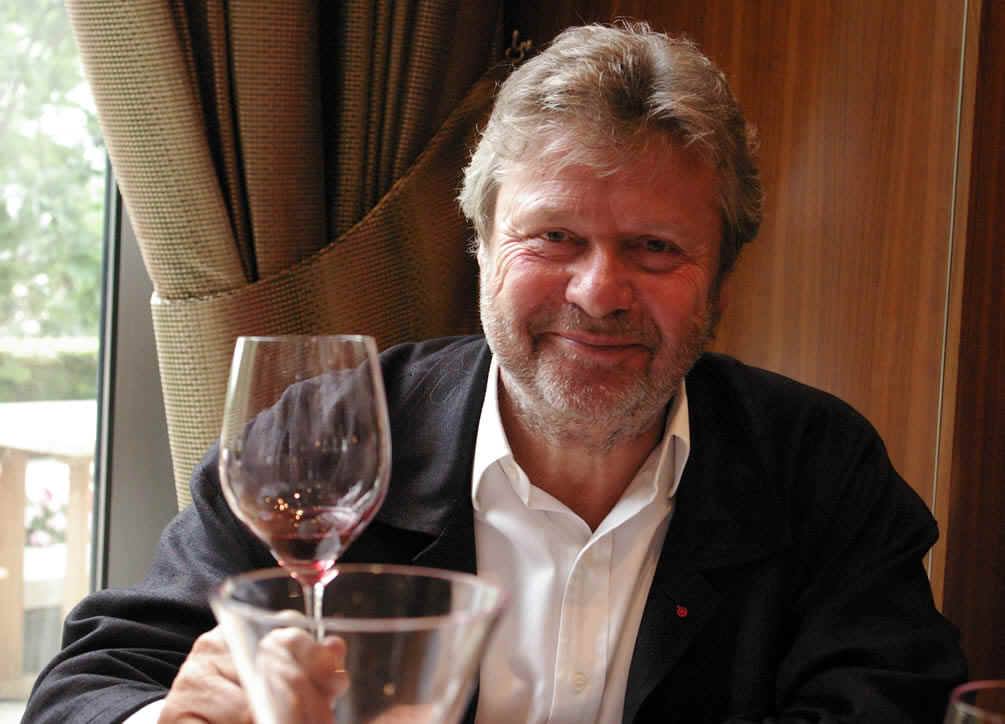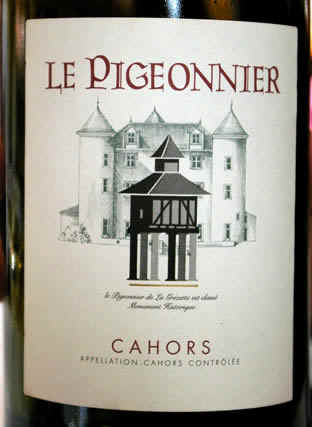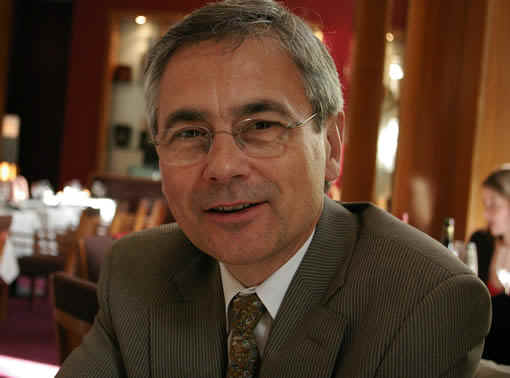|
The
interview
Alain Dominique Perrin: celebrity wines from Cahors

As a wine journalist, from time to time you get to meet
famous, wealthy people who have turned to wine as a late-in-life
leisure pursuit. Commonly known as ‘lifestylers’ in the trade,
they frequently have just a passing knowledge of wine, spend lots
of money on a swanky winery and a winemaking consultant, and the
results are so-so. The wines made like this tend to be obvious,
fashioned in an international style, and ambitiously priced. They
reek of ego.
So I approached this interview slightly hesitant. Alain
Dominique Perrin is wealthy and famous, and Michel Rolland
consults for his Cahors estate, Lagrezette. The wines he makes are
the most expensive in Cahors by some margin. The signs weren’t
looking good.
But I was pleasantly surprised. Perrin is clearly a
serious wine lover, and has a very hands-on role with Lagrezette.
His relationship with Rolland is deeper than the usual
owner–consultant one. And, most significantly, the wines are
really good. ‘Wine is my passion and hobby, and I’ve invested
a lot of money in it’, states Perrin. Indeed, he has a wine
cellar of 22 000 bottles, which sounds like an acquisitive hobby
that’s run slightly out of control. ‘My family can drink for
four generations’, he quips.
Some background information is necessary here. Perrin
is extremely famous in France, but less well known in the UK.
Indeed, when my brother-in-law, who works for a French bank, heard
that I was interviewing Perrin, he was awestruck. ‘Perrin?
He’s like God’.
Perrin’s fame largely stems from the fact that he’s
known as the man who turned the fortunes of Cartier around, as CEO
of Must de Cartier from 1976 and then, when it merged with Cartier
Jewellers, as chairman of the board of Cartier International from
1981. From 1999 he was head of the Richemont group, the second
largest luxury goods group in the world, with a bevy of famous
names in its portfolio, including Cartier, Dunhill, Vacheron
Constantin, Van Cleef & Arpels, Purdey, Officine Panerai,
Piaget, Montblanc and Montegrappa.
Perrin did hit the headlines in the UK in 2002, for
allowing his friends the Blairs, who seem to have a fondness for
hospitality, to take a holiday at Lagrezette, which Tony forgot to
include in the register of members’ interests. Perrin was also a
dinner guest at Chequers in 2003, although this invitation was
also the source of some controversy: when the guest lists from the
Blairs’ Chequers dinners were released under the freedom of
information act (these dinners were funded publically), Perrin was
listed as simply Alain Dominique. It looked like the Blairs were
embarrassed by this association, perhaps because they were afraid
that the connextion between Perrin and the tobacco industry
(Dunhill is part of the Richemont group) wouldn’t look good.
But back to the interview. What led him to Cahors?
‘It’s the most beautiful part of France’, claims Perrin:
‘I love the terroir, and I love Malbec.’ He adds that,
‘Cahors is not an easy wine—and I am not helped by the fact
that the average Cahors wine is too expensive for what it is, even
though it is cheap. I have to share the negative reputation of
Cahors.’
Perrin reveals that he almost bought Château Pavie
when it was sold nine years ago. ‘I was living in London at the
time, and I thought that I can’t live in London and go to Pavie
regularly’, he recalls. ‘It wasn’t expensive—about 200
million Francs, plus the inventory.’ He thinks that Gerard
Perse, who went on to buy the property, has done an exemplary job.
‘It’s a beautiful wine; one of the best. For me, the two best
Bordeaux wines are Pavie and Pape Clement’. Perrin guesses that
the current market value of Pavie must be £300 million. ‘Maybe
more’.
 We
turned to the wines of Lagrezette. Pigeonnier is the top cuvee,
and it was first made in 1997, by accident: a late frost meant
that the eventual harvest was at a miserly yield of 18
hectolitres/hectare, which is extremely low. Perrin and his team
tasted the wine, and it was fantastic. So a decision was made to
produce a wine like this each year by deliberately pruning for
extremely low yields. All the fruit is hand picked and hand
destemmed. The wine retails for £80 a bottle, but although this
sounds absurdly high for a Cahors, Perrin maintains that isn’t
profiteering or market positioning, but simply because it’s so
expensive to make wine this way. ‘The cost price is five times
higher’, says Perrin. And he reports that there’s a big demand
for this wine, even though it is perceived as expensive. ‘I
wouldn’t say we are selling it as a luxury good,’ says Perrin.
‘The price is high for Cahors, but not high for the best Malbec
in the world’. He adds, ‘we can’t compete in price with the
top Bordeaux wines, but with a little help from our friends the
journalists we will be able to sell Malbec at a decent price’.
Perrin reckons that at £18 the regular Château Lagrazette is
much too cheap, and it should really sell for £50. ‘Lagrazette
currently makes a loss’, admits Perrin. [However, I didn’t ask
him whether this is taking into account the cost of running a
luxury 15th century Chateau and entertaining guests, or whether
the wine is accounted for on its own without these indirect
costs.] We
turned to the wines of Lagrezette. Pigeonnier is the top cuvee,
and it was first made in 1997, by accident: a late frost meant
that the eventual harvest was at a miserly yield of 18
hectolitres/hectare, which is extremely low. Perrin and his team
tasted the wine, and it was fantastic. So a decision was made to
produce a wine like this each year by deliberately pruning for
extremely low yields. All the fruit is hand picked and hand
destemmed. The wine retails for £80 a bottle, but although this
sounds absurdly high for a Cahors, Perrin maintains that isn’t
profiteering or market positioning, but simply because it’s so
expensive to make wine this way. ‘The cost price is five times
higher’, says Perrin. And he reports that there’s a big demand
for this wine, even though it is perceived as expensive. ‘I
wouldn’t say we are selling it as a luxury good,’ says Perrin.
‘The price is high for Cahors, but not high for the best Malbec
in the world’. He adds, ‘we can’t compete in price with the
top Bordeaux wines, but with a little help from our friends the
journalists we will be able to sell Malbec at a decent price’.
Perrin reckons that at £18 the regular Château Lagrazette is
much too cheap, and it should really sell for £50. ‘Lagrazette
currently makes a loss’, admits Perrin. [However, I didn’t ask
him whether this is taking into account the cost of running a
luxury 15th century Chateau and entertaining guests, or whether
the wine is accounted for on its own without these indirect
costs.]
These wines have received some critical acclaim. ‘I
never forget the first time Robert Parker tasted the 1997
Pigeonnier’, recalls Perrin. ‘He looked at me and said, “Oh,
this is a monster!”’ I asked him whether the Parker score was
important for selling this wine. ‘Of course, the RP score is
important in the USA. Maybe not in the UK and France. Remember, he
made Guigal.’
If ambitious, high quality wines, fetching high prices,
can be made in Cahors, why aren’t more people doing it?
According to Perrin, the reason more people aren’t doing this
sort of thing in the Southwest of France is simple: it costs lots
of money. People who aim to make the very best wines in this
region tend to lose money. ‘The consumer isn’t prepared to pay
enough for that part of France’, laments Perrin.
Our conversation turned more broadly to the state of
the French wine industry. ‘Average quality wines are in trouble
today, because the cost of labour in France is so much higher than
in other parts of Europe, and in other regions across the
world’. Perrin reveals that earlier that day he’d been meeting
with new French minister of agriculture, discussing the state of
the wine industry. So what are the solutions to the problems the
French wine industry? ‘The key problem is to find a way to
decrease costs,’ claims Perrin. He reveals that he was a member
of the INAO for 14 years. ‘When I spoke to the minister of
agriculture this morning I explained that we have to deregulate,
and give more freedom to vignerons. We must simplify. We need to
accept the fact that some appellations must be sacrificed. We need
to get rid of perhaps 100 today.’
While we were touching on the subject of politics I
asked about France’s new president. ‘Sarkozy could the the
right guy for France. The minister of agriculture will have to
follow and do with wine what Sarkozy is doing with tax to get wine
back on track’.
But overall, Perrin is hopeful for the future. ‘More
and more young people are drinking wine. The US market is opening
up tremendously, even though the UK is difficult for France.’

Jean Courtois, Perrins's general
manager at Lagrezette
Perrin explained that he was disappointed by the
performance of his wines in the UK market. ‘In the UK there is a
special way of selling wine. You invite people to taste wine and
they buy what they want to buy. You don’t really have people on
the road hard selling the wine.’ He adds that, ‘in the UK
people don’t take risks’. The situation is somewhat different
in France, where people want to discover new wines, and salesmen
are on the road selling the product more actively. His number 1
market for Lagrezette is France, followed by Canada, Japan and the
USA. ‘The UK should be 2 or 3, but it’s number 7. I sell more
directly from the estate to English people than I do in the UK!’
But he’s not looking to do better in the UK market
for financial reasons. ‘It’s my second home’, says Perrin.
‘I’m eager to sell more to be recognized more.’
What does he like to drink? ‘I don’t like Australian wines too
much; they are too sweet.’ He likes Argentinean wines and
Chilean wines. ‘I have some Harlan from the USA; I like Spain
and Italy; France obviously; I have a decent quality of Bordeaux,
but no more than 30%.’ Perrin is clearly quite open to wines
from all around the world: ‘When you look for it, you always
find a guy somewhere who is passionate and comes out with a
beautiful product.’
Michel Rolland has been consulting here since 1988, and
the Perrin–Rolland relationship goes quite deep. They first met
through a contact at Mouton Rothschild.
‘His first wine for me was in 1989, and at that time he
didn’t do much consulting’, reveals Perrin. ‘We see each
other privately; he’s a good friend of mine’. Rolland visits
Lagrazette three or four times a year, and has an assistant who
comes at least seven times. Rolland is concerned with the
vineyard, as well as the winery. ‘He does all the blending. We
blend after the wines have been aged in oak after two years. Each
variety is aged separately; it’s very sophisticated blending’.
With wine, though, the proof is in the pudding. What do
the wines taste like? We tasted two, the 2001 Lagrezette and the
1999 Pigeonnier, and my notes are below. I was impressed: these
are quite serious wines that have real character. They taste like
Cahors, and avoid the dreaded anonymity of ‘international’
style wines. It’s a bit of a relief, because it would have made
my task of writing this interview up much more difficult had these
been spoofy, over-ripe caricatures of fine wine.
Château Lagrezette 2001 Cahors
Very deep colour. Stylish nose of dark, brooding black fruits,
with just a hint of minerally, earthy wildness. Nicely complex.
The palate is classy with a nice, earthy, spicy structure
underneath layered, dark minerally fruits. It’s starting to show
some evolution: there’s plenty of fruit here, but also some
complexity. It’s not just fruit driven. Delicious. 91/100
Château Lagrezette Le Pigeonnier 1999 Cahors
Dark purple/black colour. Remarkable nose: intense, lush,
sweetly fruited with blackberry, blackcurrant and some minerality
and spice. Great balance, with nothing sticking out. The palate is
beginning to develop, with loads of dense but smooth dark fruits
hiding the substantial tannic structure. Beginning to get a bit
earthy: it will be interesting to see how this evolves. A lovely
wine. ‘You can recognize the Malbec here’, says Perrin.
‘This is a wine you can keep for another 15 years’. 93/100
Wines tasted 06/07
Find
these wines with wine-searcher.com
Back
to top
|

